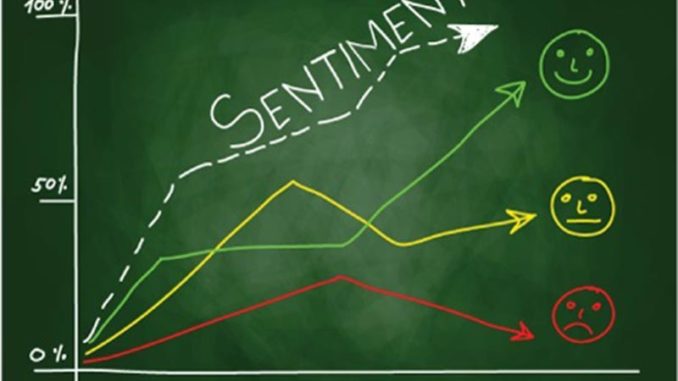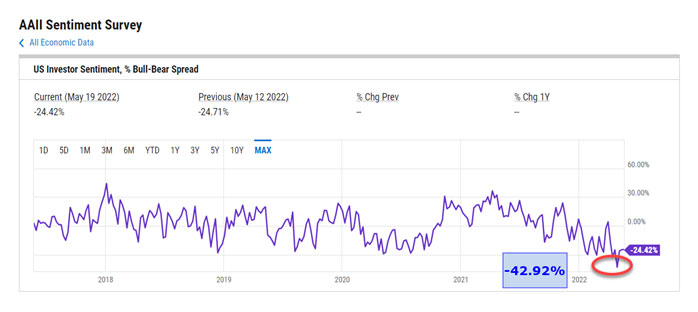
An S&P 500 Bear Market: How to Cope With All the Differing Opinions By, D.R. Barton, Jr. By Van Tharp Trading Institute
The broader U.S. markets sold off earlier this week into bear market territory. I’ve been overwhelmed by how negative everyone has been about this decline – and not only the media. Just recently the American Association of Individual Investors Bull/Bear spread hit its worst level since 2009 with the bullish component at an amazing 30-year low (data back to 2017 shown below):
There is so much competing data out there about where the market goes next; I thought we could all step back and look at data overload with a saying that has been with me since my teen years. So, let’s reminisce for a moment…
I still remember that day, 42 years ago, as if it were yesterday. (How’s that for a trite opening?) It was actually a very odd thing to remember.
I was helping a friend work on his older model Toyota Celica. (I held wrenches and could remember where he laid parts when he took them off.)
He found that the valve cover gasket was the reason for his oil leak. Not wanting to run to the auto supply store, he decided to use a product that is essentially a liquid gasket (Form-A-Gasket I think it’s called).
As he put on the first layer (without reading the instructions, of course), I remember thinking that this was a really awesome product. And the astringent odor of the solvent volatilizing was something to behold! After the first layer partially set, he then proceeded to add a second, even thicker, layer. Not satisfied with that, he then glopped on still more.
Being more than just a stand-by observer, I asked why he squeezed so much goo out of the tube and onto the valve case. His response (referenced above) will forever be burned into my brain:
“Enough is too little. More is better. Too much is just right.”
And while that approach may work for applying liquid gasket, I think data collection is a tactic that truly hinders many traders and investors because it turns into a coping mechanism that traders and investors use to deal with uncertainty. For many, there is comfort (and not much decisive action) in the collection of a massive amount of information.
These folks are the shade tree mechanics of the trading world. They have before them a limitless supply of liquid gasket, so they set out to use every last drop. No news story goes unread. No technical indicator goes uninvestigated. No piece of fundamental analysis is skipped.
More data is better. Too much is just right! And while getting sufficient input for a decision is prudent, there are problems with gathering too much data.
Endless Feedback Loops
One of the main problems that occurs when one looks at too much data is that many of those pieces of data contradict themselves. One technical indicator says to buy, while another says to sell. One analyst says, “A stock is a screaming value” while another says that it’s a lead balloon.
What is the natural tendency to overcome this contradiction? More data, of course. Let’s see if I can take a poll of three more analysts to see what they think about this stock. Or, what does the super-big-MACD-RSI-momentum-quick-stochastic-eieio oscillator tell me about what’s happening here? We look for something to break the tie.
But a funny thing happens on the way to data-driven consensus. The decision-making waters get muddier, not clearer.
In fact, if we get enough analysts agreeing on something, it’s usually a much safer bet to go the other way. And while seeing how many momentum indicators we can get to line up on the side of overbought or oversold is a fun mathematical and intellectual exercise, it often leads us to find out that the instrument we’re watching is about to stay overbought or oversold for a long time.
This issue of dealing with data overload is a huge one, so we’ll continue to discuss it from time to time. For now, the short answer is to find a moderate number of useful independent variables to help guide your decisions. Too few and you make decisions that are no better than a coin toss. Too many, and your decisions begin to look like either over-optimization (curve fitting) or consensus-building.
Today, I joined in with RJ Hixson while he led a new session of the How to Develop a Winning Trading Systems That Fit You Workshop. They are learning over the next six weeks, how to systematically overcome data overload.
Van Tharp Trading Institute Live Online Workshops Books Home Study Courses Free Resources Blog


